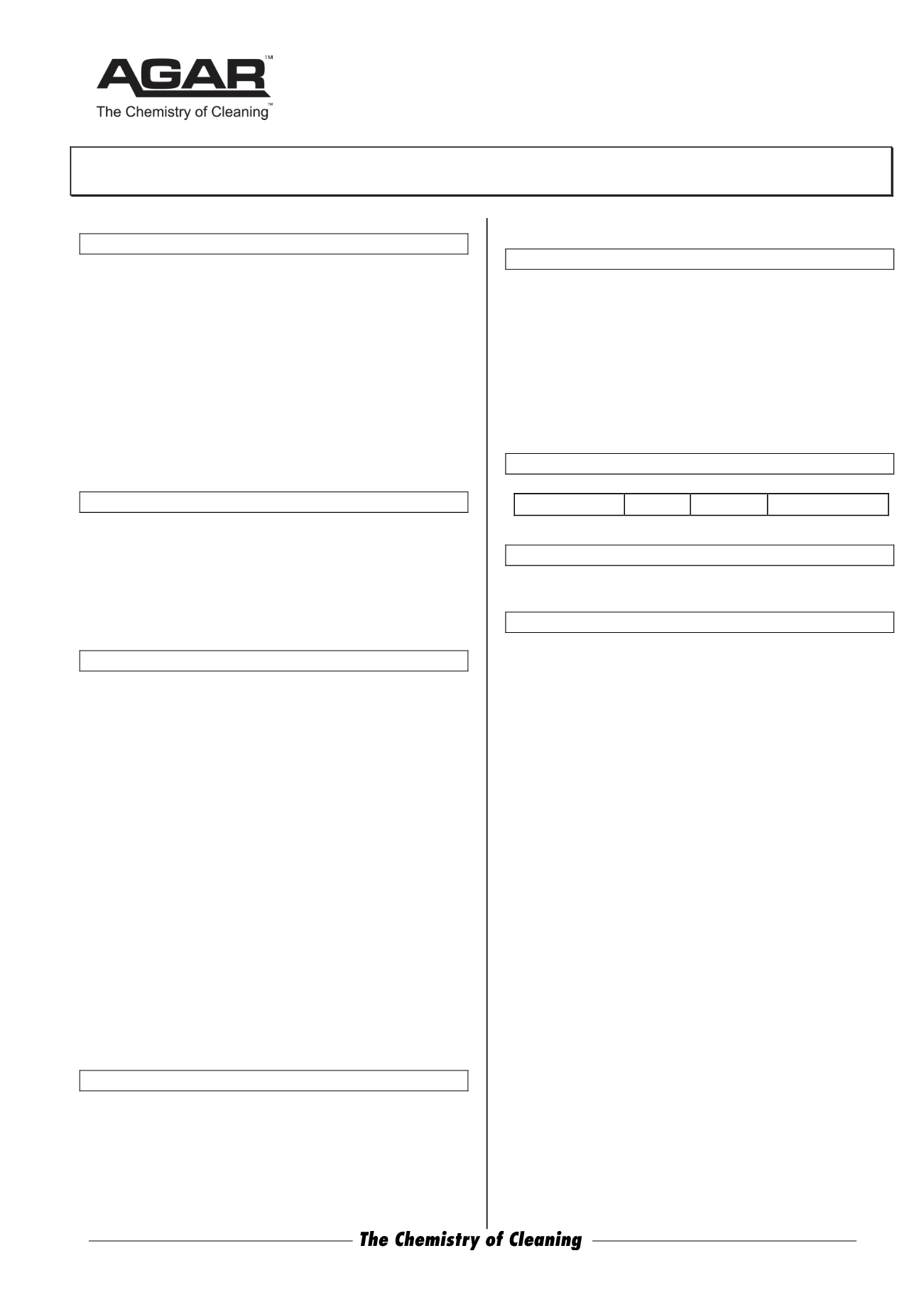

ABN 80 004 726 890 | MADE IN AUSTRALIA
Safety Data Sheet
Issued: November 18, 2014
Page 2 of 2
ISOPROPYL ALCOHOL
9 PHYSICAL AND CHEMICAL PROPERTIES
Appearance: Clear, colourless liquid
Odour: Alcohol type
pH = N/A
Vapour Pressure (20ºC) : 4.3 kPa
Vapour Density (20ºC) : > 1.0 kPa
Boiling Point : 82ºC
Flash Point : 12 ºC
Explosive Limits (LEL – UEL) : 1.8 – 12%
Specific Gravity (15ºC) : 0.785 g/mL
Autoignition Temperature : > 350 ºC
Viscosity (20ºC) : N/A
Percent Volatiles : 100%
Solubility with water : infinite
10 STABILITY AND REACTIVITY
Stable.
Hazardous polymerization: None.
Hazardous reactions: Violent, explosive reactions with metal
oxides, oxidising agents or halogens. Stored mixtures with
MEK produce explosive peroxides. Increased rate of peroxide
formation with isobutanol. Peroxide formation sharply
decreases the autoignition temperature.
11 TOXICOLOGICAL INFORMATION
Health Effects: Acute –
Swallowed:
The single lethal dose for humans is approximate
250ml, however 100ml can be fatal. Symptoms of
overexposure include: flushing, pulse rate decrease, blood
pressure lowering, anaesthesia, narcosis, headaches,
dizziness, mental depression, hallucinations, distorted
perceptions, respiratory depression, nausea or vomiting,
coma.
Eye:
May cause irritating to eyes and can cause corneal
burns.
Skin:
May be irritating to the skin with prolonged exposure. It
may result in dryness and cracking.
Inhalation:
May cause irritating to the respiratory tract. In high
doses, this product has narcotic effects. At concentrations of
400 ppm or higher, the product may induce a mild narcosis,
with transient effects.
Health Effects: Chronic – This product is easily absorbed by
the skin yielding a narcotic action. People with pre-existing liver
or kidney conditions must avoid unnecessary product exposure
(metabolises similarly to ethanols).
Toxicity Data: 2-propanol : 5045 mg/kg (oral, rat)
TDLo : 223 mg/kg (oral, human)
12 ECOLOGICAL INFORMATION
Ecotoxicity: Fish toxicity (rainbow trout, goldfish, bluegill) :
LC50 (96 hr) : expected to be toxic to aquatic
organisms.
Persistence and degradability: Can degrade rapidly in air.
Expected to biodegrade rapidly
and be ‘readily biodegradable’
according to OECD guidelines.
Mobility: Highly volatile and will rapidly evaporate to the air if
released into the water.
Advice: -
13 DISPOSAL CONSIDERATIONS
Empty packaging should be taken for recycling, recovery or
disposal through a suitably qualified or licensed contractor.
Care should be taken to ensure compliance with national and
local authorities. Packaging may still contain fumes and
vapours that are flammable and harmful. Ensure that empty
packaging is allowed to dry.
This product is NOT suitable for disposal to landfill, sewers,
drains or waterways. This product is ashless and can be
burned directly in appropriate equipment.
14 TRANSPORT INFORMATION
UN No.: 1219
Class: 3 Pkg.Grp: II
Hazchem: 2 [Y]E
15 REGULATORY INFORMATION
Poisons Schedule Number: 5
16 OTHER INFORMATION
AICS Listing:
All components of Isopropyl Alcohol are listed on
the Australian Inventory of Chemical Substances (AICS).
Issue Date:
This SDS issued on November 18, 2014
shall remain
valid for 5 years unless a new SDS is issued in the meantime.
Please contact Agar Cleaning Systems PL to ensure you have the
latest version of this product’s SDS.
Abbreviations and Definitions of terms used:
<
less than
>
greater than
AICS
Australian Inventory of Chemical Substances
CAS
Chemical Abstracts Service (Registry Number)
COD
Chemical Oxygen Demand
deg C
Degrees Celsius
g
gram
g/L
grams per litre
HSIS
Hazardous Substance Information System
kg
kilogram
L
Litre
LC50
The concentration of a material (inhaled) that will be lethal to
50% of the test animals.
LD50
The dose (swallowed all at once) which is lethal to 50% of a
group of test animals.
m3
Cubic metre or cu.m.
mg
milligram
mg/m3
milligrams per cubic metre
miscible
A liquid that mixes homogeneously with another liquid
N/A
Not applicable
N/K
Not Known
NIOSH
National Institute for Occupational Safety and Health
non-haz
Non- hazardous
PEL
Permissible Exposure Limit
ppb
Parts per billion
ppm
Parts per million
‘Skin’
Ingredient may be absorbed through the skin
STEL
Short term exposure limit
TLV
Threshold Limit Value
TWA
Time Weighted average
UN
United Nations (Number)
wt
weight
The information in this Data Sheet is based on our present knowledge. However, this
shall not constitute a guarantee for any specific product features and shall not establish a
legally valid contractual relationship. Agar Cleaning Systems accepts no tortious or
contractual liability for any loss or damages suffered as a consequence of reliance on the
information and advice contained herein.
End of SDS.


















